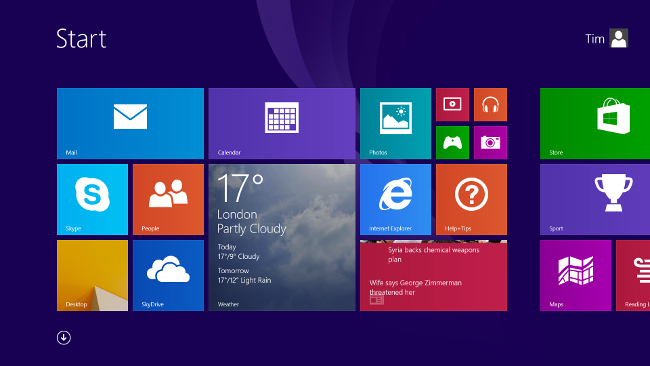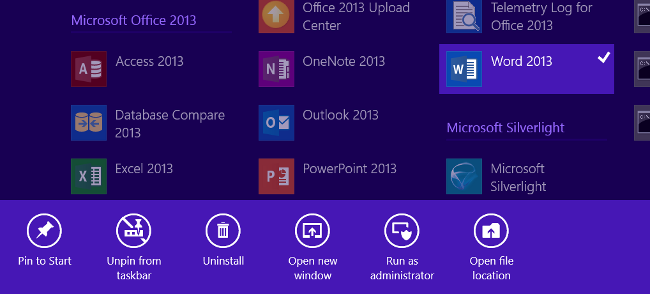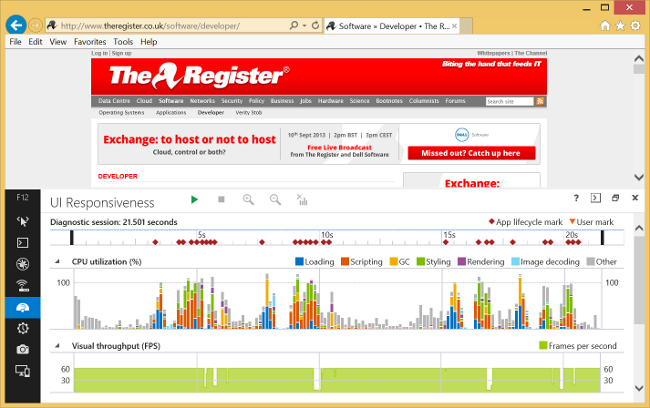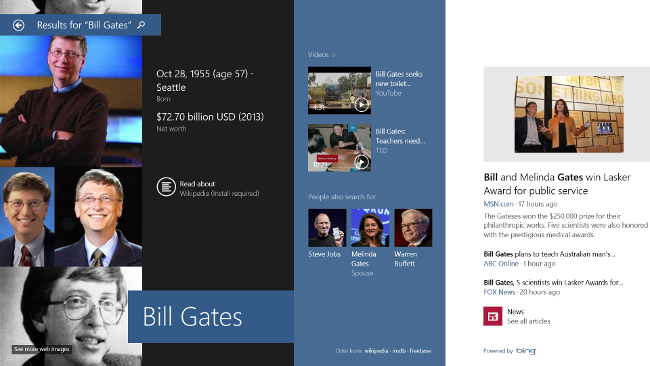Original URL: https://www.theregister.com/2013/09/12/windows_eight_one_review/
Windows 8.1: Microsoft's reluctant upgrade has a split-screen personality
El Reg has a sniff around the RTM version
Posted in Software, 12th September 2013 10:59 GMT
Review Microsoft will release Windows 8.1, a free update for Windows 8, on 18 October. The plan had been for no pre-release code until then, but Microsoft has back-tracked.
The release to manufacturing (RTM) code is now available early to developers and IT professionals via Microsoft’s MSDN and TechNet subscription sites.
There are indications, though, the “release” build is not quite what will be released.
Company vice president Stephen "Guggs" Guggenheimer said: “The primary purpose of Windows 8.1 RTM and Visual Studio 2013 RC availability is for testing as our engineering teams continue to refine and update the product and tools in preparation for Windows 8.1 general availability on October 18.”
Who knows, perhaps SkyDrive – Microsoft’s cloud storage platform, which is prominent in Windows 8.1 – will be renamed in time for general availability following the High Court’s June ruling that it might be confused with BskyB. Microsoft on Monday announced its intention to appeal that decision.
Major changes are unlikely though, so I put the RTM through its paces on a Surface Pro - perhaps its most natural home.
Tablet-desktop mutant hybrid – does it work?
There are two questions to ask of Windows 8.1. The first is how well it delivers as part of Microsoft’s devices and services strategy. In this context, Windows is being reinvented as a tablet-friendly, cloud-centric operating system, with the traditional desktop retained both for compatibility and for heavyweight applications such as Office, Visual Studio, Autodesk AutoCAD or Adobe Photoshop, which do not fit the new-style app model.

Looks familiar - the Windows 8.1 Start screen, only less straight jacketing than before
The second question is more prosaic. The first release of Windows 8 contrived to alienate existing Windows users, to the extent that many prefer Windows 7 or, if stuck with 8, do their best to make it work like Windows 7. They do this using Start menu replacements and changing file associations for things like images and PDF documents back to desktop applications, to avoid the “Modern” user interface as far as possible. Can Windows 8.1 at least persuade users that it is not actually a downgrade from 7?
Microsoft has gone some way to make Windows 8 less awkward for desktop users, though you sense that it has done so through gritted teeth. Why else is the option to boot to the desktop, rather than the Start screen, buried in Taskbar and Navigation properties, rather than in PC Settings?
That said, if you check this option, along with two other options to “Show the apps view automatically” and to “List desktop apps first”, the effect is dramatic. Not only does Windows now boot to the desktop, but also, when you click the re-instated Start button, you get a list of desktop apps, with smallish icons rather than large tiles, and in familiar groups like “Windows Accessories” and, if installed, “Microsoft Office”.
It is still a Start screen, but for those users who intend to live in the desktop it’s more approachable than before. Fix the file associations, and the transition from Windows 7 becomes easy.

Newly installed apps must be retrieved from deep inside Windows 8.1 and pinned to the Start screen
This being the case, why does Microsoft not have a simple first-use dialog box asking users whether they would prefer a tablet-oriented experience, or a desktop one? There is still, one suspects, a desire to pull users into the new world whether willingly or not; though OEM customisation may mean that Windows 8 does become more desktop-centric out of the box for most users.
The Start screen has another key change. Newly installed apps no longer appear there by default. If you install Office, for example, applications like Word and Excel do not appear in the main tiled view. In order to get it there, you need to scroll down to the Apps view (small icons rather than big tiles), right-click or tap and hold on the icon for Word, and select Pin to Start. Further, you can resize the tiles between Large, Small, Medium and Wide.
In other words, the Start screen is, aside from a few default apps, now a blank canvas for users to customise. While this is a good thing, and makes the Start screen a better app launcher than the old Start menu, there is still an issue for new users who may wonder “where is Office” since by default it is nearly invisible.
Split-screen personality: Two browsers, two environments
Windows 8.1 retains the awkwardness of two web browsers, one in the Modern environment and one on the desktop, but these are now upgraded to Internet Explorer 11. This is a significant update, though the user interface is little different. Press F12, for example, and a new and improved developer tools panel appears, with a analyser, JavaScript debugger and more.
On the standards front, IE11 has WebGL support (though still somewhat behind that in rival browsers according to this demo list), improved Canvas support, high DPI (screen resolution) support, improved touch support with features like press and hold to simulate mouse hover, and a range of other improvements.

New and improved developer tools panel include analyser, JavaScript debugger and more
SkyDrive is now more deeply baked into the operating system. It is also cleverer than before, with the entire contents of SkyDrive folders visible, but only downloaded on demand, unless you right-click and choose "Make available offline". Pictures are represented by thumbnails unless you demand the whole file. The SkyDrive Store app now supports the same offline cache as the desktop version.
Talking of Store apps, the way these work has changed. Microsoft developer evangelist Jerry Nixon helpfully identifies the key differences while observing: “New Windows users had serious trouble with some Windows 8.0 features. Even tenured Windows users had deep adoption anxiety.” In other words, Microsoft made some fundamental mistakes in its first go at a tablet user interface.
Second time's a charm
The changes begin with search. Users, as Nixon explains, do not find the Windows 8 Charms bar intuitive as a way of searching within an app, so the new guidance asks app developers to put search controls within the main user interface, using a new SearchBox control.
The second change is Microsoft now encourages a more flexible approach to app design, rather than following guidelines that are rigid to the point of repetitiveness, including a smaller primary grid unit of 5x5 units instead of 20x20. In consequence, future Store apps may be less wasteful of screen space.
Third, the fixed split view in Windows 8.0, when two apps are shown side by side, has gone. Now users who figure out the gesture for displaying two apps simultaneously can size them as they wish, though the split is horizontal only. You can also display more than two apps if your screen is big enough, and have Store apps on multiple displays.

Second time without the Charms - Windows 8.1 attempts more intuitive search
Store apps, which are built on a set of APIs called the Windows Runtime, gain new capabilities in Windows 8.1, including support for USB and Bluetooth devices, and new controls including Hub, Flyout and Date and Time pickers. There are also enhancements to existing controls. Developers I spoke to at Microsoft’s Build conference in June seemed happy with the changes. “It’s caught up with Silverlight,” one told me: faint praise perhaps, but showing that the 8.0 app platform was not ready.
The Search app also deserves a mention. Search “Everywhere” from the Charms menu, and an app pieces together local and web results into a multimedia view that works brilliantly for certain types of search. It is an excellent app. The question is: will users who are stuck in the desktop ever discover it? That question expresses Microsoft’s difficulty. The more it steers users towards the Windows 8 tablet platform, the more complaints it gets from bemused and often conservative Windows users. The more it enables user to stay in the desktop environment, the harder it becomes to establish its new app platform.
Windows 8.1 is a generous free upgrade and users of Windows 8.0 should not hesitate to upgrade. It also improves on Windows 7.0, the caveat being it requires some adjustment and learning, which users who are not interested in the tablet app platform may, reasonably enough, be unwilling to give. That said, the improved usability means it will be more acceptable to consumers and something that businesses, after suitable customisation, are more likely to deploy.
A decent release, then, but one that still leaves open questions. Will Microsoft ever fully establish the Store App platform, with its still-disappointing range of apps?
Will Windows 8.1 ever be perceived as a tablet platform, rather than as a way to run desktop apps because you have to? Will Microsoft or its OEM partners ever work out how to deliver Windows 8.1 devices that are simple, attractive and as cheap as they need to be to compete with Android and iOS?
Not an easy task, but this more palatable Windows 8 is a necessary step on the way. ®